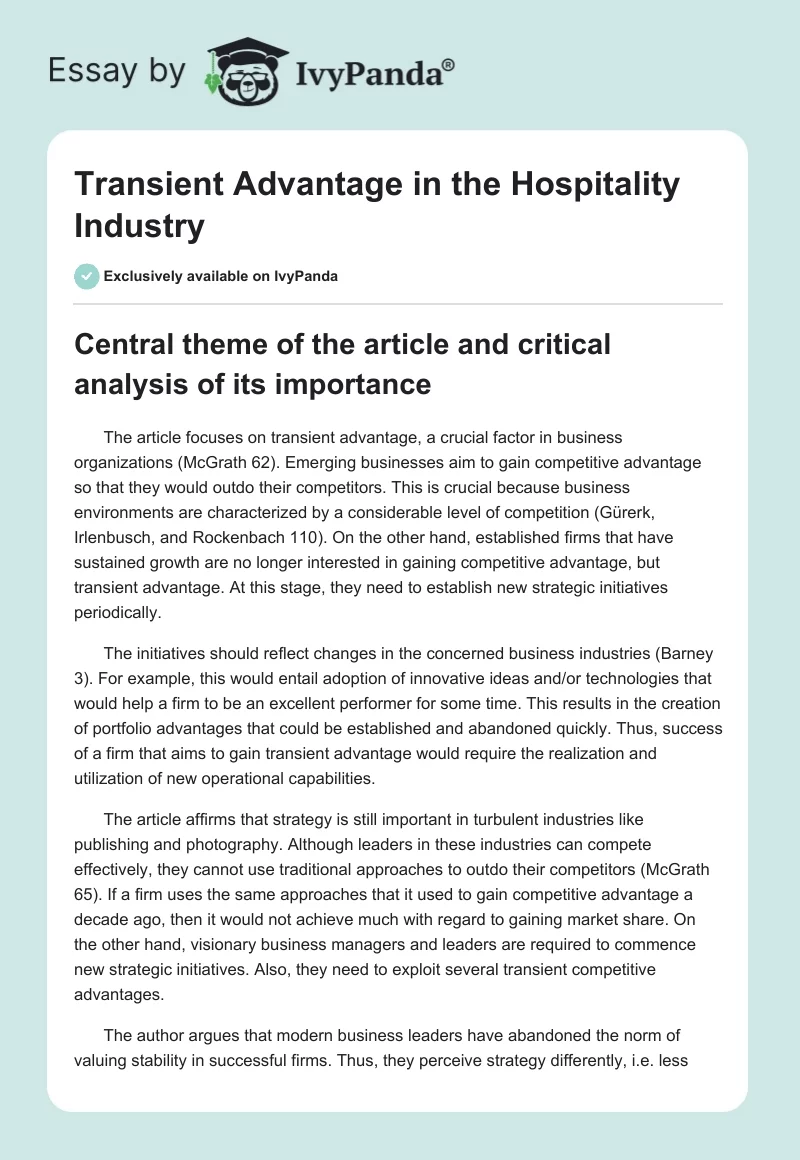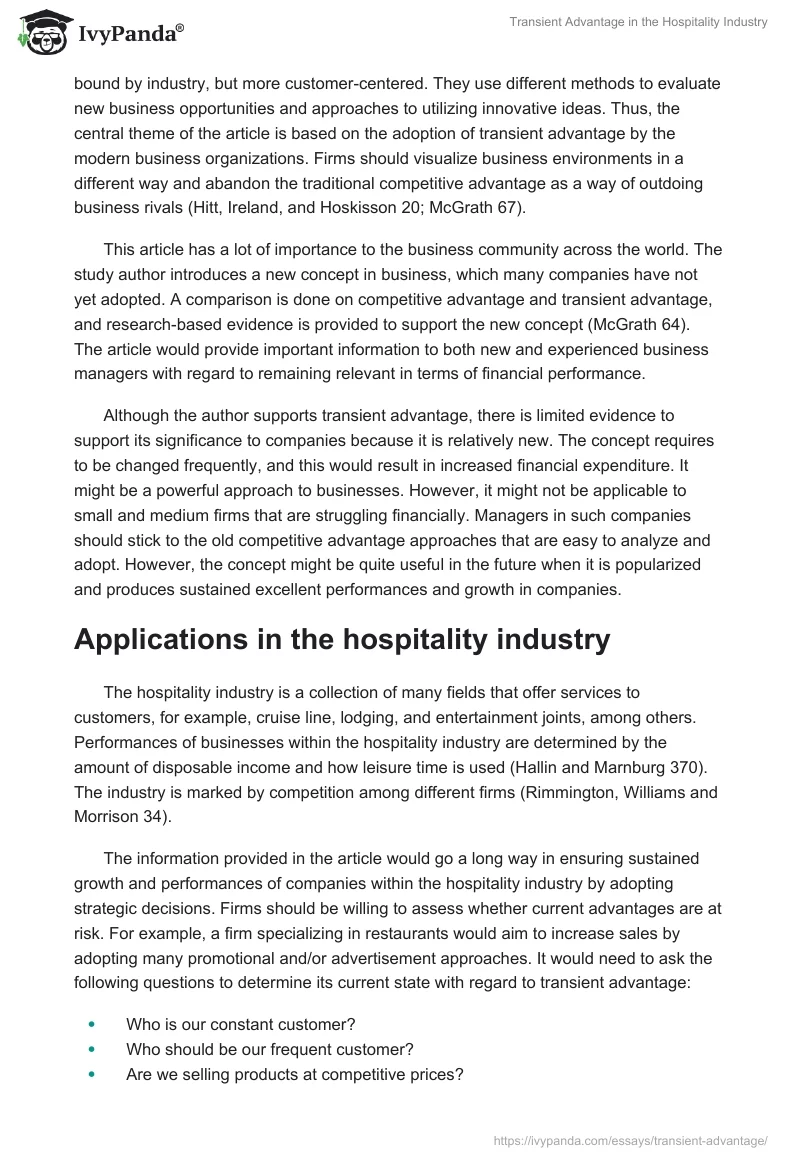Central theme of the article and critical analysis of its importance
The article focuses on transient advantage, a crucial factor in business organizations (McGrath 62). Emerging businesses aim to gain competitive advantage so that they would outdo their competitors. This is crucial because business environments are characterized by a considerable level of competition (Gürerk, Irlenbusch, and Rockenbach 110). On the other hand, established firms that have sustained growth are no longer interested in gaining competitive advantage, but transient advantage. At this stage, they need to establish new strategic initiatives periodically.
The initiatives should reflect changes in the concerned business industries (Barney 3). For example, this would entail adoption of innovative ideas and/or technologies that would help a firm to be an excellent performer for some time. This results in the creation of portfolio advantages that could be established and abandoned quickly. Thus, success of a firm that aims to gain transient advantage would require the realization and utilization of new operational capabilities.
The article affirms that strategy is still important in turbulent industries like publishing and photography. Although leaders in these industries can compete effectively, they cannot use traditional approaches to outdo their competitors (McGrath 65). If a firm uses the same approaches that it used to gain competitive advantage a decade ago, then it would not achieve much with regard to gaining market share. On the other hand, visionary business managers and leaders are required to commence new strategic initiatives. Also, they need to exploit several transient competitive advantages.
The author argues that modern business leaders have abandoned the norm of valuing stability in successful firms. Thus, they perceive strategy differently, i.e. less bound by industry, but more customer-centered. They use different methods to evaluate new business opportunities and approaches to utilizing innovative ideas. Thus, the central theme of the article is based on the adoption of transient advantage by the modern business organizations. Firms should visualize business environments in a different way and abandon the traditional competitive advantage as a way of outdoing business rivals (Hitt, Ireland, and Hoskisson 20; McGrath 67).
This article has a lot of importance to the business community across the world. The study author introduces a new concept in business, which many companies have not yet adopted. A comparison is done on competitive advantage and transient advantage, and research-based evidence is provided to support the new concept (McGrath 64). The article would provide important information to both new and experienced business managers with regard to remaining relevant in terms of financial performance.
Although the author supports transient advantage, there is limited evidence to support its significance to companies because it is relatively new. The concept requires to be changed frequently, and this would result in increased financial expenditure. It might be a powerful approach to businesses. However, it might not be applicable to small and medium firms that are struggling financially. Managers in such companies should stick to the old competitive advantage approaches that are easy to analyze and adopt. However, the concept might be quite useful in the future when it is popularized and produces sustained excellent performances and growth in companies.
Applications in the hospitality industry
The hospitality industry is a collection of many fields that offer services to customers, for example, cruise line, lodging, and entertainment joints, among others. Performances of businesses within the hospitality industry are determined by the amount of disposable income and how leisure time is used (Hallin and Marnburg 370). The industry is marked by competition among different firms (Rimmington, Williams and Morrison 34).
The information provided in the article would go a long way in ensuring sustained growth and performances of companies within the hospitality industry by adopting strategic decisions. Firms should be willing to assess whether current advantages are at risk. For example, a firm specializing in restaurants would aim to increase sales by adopting many promotional and/or advertisement approaches. It would need to ask the following questions to determine its current state with regard to transient advantage:
- Who is our constant customer?
- Who should be our frequent customer?
- Are we selling products at competitive prices?
- Do we satisfy needs of customers?
- Are customers still interested in what we offer?
- What do our loyal customers like most about our services?
- Where is competition emerging?
- Had we anticipated this competition?
- Do we value our workers? How is the employee rate of turnover?
- What does our financial performance indicate?
These questions would help the management to understand crucial parameters that would either impact the restaurant positively or negatively. They concentrate on four major areas. First, the questions would enable the management to understand customer dynamics. The dynamics would help to establish whether the firm relies on loyal customers or new customers who go to the restaurant unexpectedly. Second, matters with regard to product prices would be known, and the information would be utilized by the management to adopt pricing strategies that would increase market share and sales. Third, competition dynamics would be analyzed to aid the firm to establish measures that would outdo business competitors.
If the competition had been anticipated, then it would imply that the firm did not adopt effective approaches to outperform its rivals. However, if the competition is identified to emerge from new and unanticipated business organizations, then the firm would need to analyze the factors that would be making the new business outdo it. Fourth, employees would be analyzed to decipher whether they are comfortable working for the business establishment. The information in the article would be utilized by firms in the hospitality industry to develop and manage initiatives, which would be short-lived.
Business managers would need to view business as arenas, but not industries. Traditionally, businesses were analyzed in relation to the industries in which they operated. However, this would be misleading in the contemporary world because industry lines are blurring. It would be important for managers in the hospitality industry to set many themes, which workers would experiment. The advantage of setting broad themes is that many of the themes might yield positive results. Also, workers would feel motivated if they are offered opportunities to experiment important themes for their organizations.
The hospitality industry leaders need to use the information in the article to develop and utilize metrics that form a platform for entrepreneurial growth. The platform would also help firms to concentrate on experiences and solutions to identified problems that impact them negatively. In addition, business organizations within the hospitality industry would need to establish strong relationships and networks (Groysberg and Slind 77). This would result in an industry that would be characterized by sustained growth because firms would aim to achieve common goals. The approaches would ensure that decision makers in the hospitality industry move their firms forward.
Development of the strategic management theory
The strategic management theory focuses on initiatives adopted by a firm’s top management with regard to utilization of resources in order to achieve improved performance (Chrisman, Chua and Sharma 556; Frigo and Anderson 34; Kapferer 15; McGrath 68). Strategic managers need to analyze external issues like customers’ needs and respond to forces that bring about competition. The information in the article would aid in development by providing crucial facts regarding the following issues that are often misunderstood:
- The first-mover trap
- The superiority trap
- The quality trap
- The hostage-resources trap
- The white-space trap
- The empire-building trap
- The sporadic-innovation trap
The explanation offered about the traps would help strategic managers to develop the strategic management theory that is clear and that could be applied broadly across the world because it would provide sufficient background. The information would also be essential in developing the strategic management theory that would adopt the following shifts:
- Think about arenas, but not business industries
- Establish broad objectives and empower workers to think critically to achieve them
- Learn healthy disengagement, but avoid unplanned restructuring
- Always ensure that innovations are systematically adopted and supported
- Form alliances and work as team
The shifts in business thinking would result in the development of the strategic management theory that is cognisant with modern approaches to business critical thinking. In conclusion, the information would ensure that the strategic management theory would be used to gain transient advantages by business organizations.
Works Cited
Barney, Jay B. “Purchasing, Supply Chain Management and Sustained Competitive Advantage: The Relevance of Resource‐based Theory.” Journal of Supply Chain Management 48.2 (2012): 3-6. Print.
Chrisman, James J., Jess H. Chua, and Pramodita Sharma. “Trends and directions in the development of a strategic management theory of the family firm.” Entrepreneurship theory and practice 29.5 (2005): 555-576.
Frigo, Mark, and Richard J. Anderson. Strategic Risk Mangement: The New Core Competency. Hoboken, NJ: John Wiley & Sons Limited, 2012. Print.
Groysberg, Boris, and Michael Slind. “Leadership is a conversation.” Harvard business review 90.6 (2012): 76-84. Print.
Gürerk, Özgür, Bernd Irlenbusch, and Bettina Rockenbach. “The competitive advantage of sanctioning institutions.” Science 312.5770 (2006): 108-111. Print.
Hallin, Carina Antonia, and Einar Marnburg. “Knowledge management in the hospitality industry: a review of empirical research.” Tourism Management 29.2 (2008): 366-381. Print.
Hitt, Michael, R. Duane Ireland, and Robert Hoskisson. Strategic management cases: competitiveness and globalization. Stamford, CT: Cengage Learning, 2012. Print.
Kapferer, Jean-Noel. The new strategic brand management: Advanced insights and strategic thinking. Center City, PA: Kogan page publishers, 2012. Print.
McGrath, Rita Gunther. “Transient advantage.” Harvard Business Review 91.6 (2013): 62-70. Print.
Rimmington, Michael, Clare Williams, and Alison Morrison. Entrepreneurship in the hospitality, tourism and leisure industries. London, United Kingdom: Routledge, 2012. Print.


